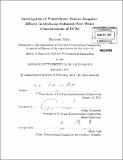| dc.contributor.advisor | Philip Gschwend. | en_US |
| dc.contributor.author | Follett, Elizabeth (Elizabeth Marie) | en_US |
| dc.contributor.other | Massachusetts Institute of Technology. Dept. of Civil and Environmental Engineering. | en_US |
| dc.coverage.spatial | n-us-ma | en_US |
| dc.date.accessioned | 2012-05-15T21:10:39Z | |
| dc.date.available | 2012-05-15T21:10:39Z | |
| dc.date.copyright | 2011 | en_US |
| dc.date.issued | 2011 | en_US |
| dc.identifier.uri | http://hdl.handle.net/1721.1/70765 | |
| dc.description | Thesis (S.M.)--Massachusetts Institute of Technology, Dept. of Civil and Environmental Engineering, 2011. | en_US |
| dc.description | Cataloged from PDF version of thesis. | en_US |
| dc.description | Includes bibliographical references (p. 161-164). | en_US |
| dc.description.abstract | Polychlorinated biphenyl compounds (PCBs) were manufactured between 1929 and 1977 as heat exchange fluids, flame retardants, and pesticide extenders, among other uses. About 450 million pounds of PCBs are estimated to have entered the environment since manufacture. Assessing the hazard posed by these PCBs is difficult due to PCBs' strong affinity for organic carbon and black carbon, which complicates measurement of pore water concentrations. PE passive samplers are an inexpensive, fast alternative to liquid-liquid extraction of pore waters and sediment extraction with equilibrium partitioning. To demonstrate the potential of PE passive samplers to measure sediment pore water concentrations, we (a) compared observed PRC behavior over 476 days to the model of Fernandez et al. (2009), (b) investigated key data metrics including method detection limit, precision, and comparison to contract lab analysis, (c) assessed PE passive sampler results compared to directly measured pore water concentrations and sediment extraction with equilibrium partitioning, and (d) explored the capabilities of contour mapping software to infer PCB concentrations in the sediment of Lake Cochituate (Natick, MA) from a limited data set. PRC behavior of PCBs 101 and 52 was underpredicted by the model, but estimation of black carbon effects corrected this issue. Method precision was around 20% without PRC correction, but increased with PRCs due to the instability of this correction as PRC load approaches 1. Longer incubation times, thinner passive samplers, or novel materials are suggested in order to encourage PRC loss. PE passive samplers matched directly measured pore water results within a factor of 2, while sediment extraction results were over 10 times too high, suggesting the advantages of PE passive sampling over sediment extraction. Contour mapping software provided "hot spot" results much like traditional mapping, but with tweaks to hot spot size and shape due to incorporation of information from the entire data set. | en_US |
| dc.description.statementofresponsibility | by Elizabeth Follett. | en_US |
| dc.format.extent | 164 p. | en_US |
| dc.language.iso | eng | en_US |
| dc.publisher | Massachusetts Institute of Technology | en_US |
| dc.rights | M.I.T. theses are protected by
copyright. They may be viewed from this source for any purpose, but
reproduction or distribution in any format is prohibited without written
permission. See provided URL for inquiries about permission. | en_US |
| dc.rights.uri | http://dspace.mit.edu/handle/1721.1/7582 | en_US |
| dc.subject | Civil and Environmental Engineering. | en_US |
| dc.title | Investigation of polyethlyene passive samplers' efficacy in deducing sediment pore water concentrations of PCBs | en_US |
| dc.type | Thesis | en_US |
| dc.description.degree | S.M. | en_US |
| dc.contributor.department | Massachusetts Institute of Technology. Department of Civil and Environmental Engineering | |
| dc.identifier.oclc | 789669284 | en_US |
